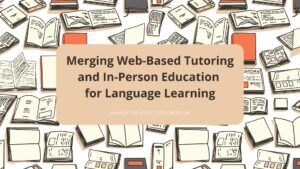Your Language Journey, Your Way: Start with a Private Tutor

Bringing Traditional Teaching Methods To Online Language Education
Online language education has rapidly grown in popularity over the past decade. With the convenience of learning from anywhere, anytime, and at any pace, it’s no wonder that students are flocking to online platforms for language instruction.
However, with this shift toward digital learning comes a concern – is traditional teaching being left behind? While online language education offers many benefits, it needs more personal touch and structure than conventional methods.
But what if we could bring those elements into virtual classrooms? This article will explore how incorporating traditional teaching methods can enhance online language education and provide students with a more comprehensive learning experience.
Join us as we delve into the benefits of combining old-school techniques with modern technology to create an exciting and engaging language-learning environment.
Table of Contents
The Benefits Of Traditional Teaching Methods
Traditional teaching methods have been the cornerstone of language education for centuries and with good reason.
One of the most significant benefits is interactive engagement – face-to-face lessons allow for real-time conversations between students and teachers. This interaction provides immediate feedback to help learners improve their pronunciation, grammar, and vocabulary.
Collaborative learning is another critical benefit of traditional teaching methods. Students are given ample opportunities to work together on group projects or in pairs during class discussions. These activities foster a sense of community within the classroom and encourage teamwork skills that will be valuable down the road.
In addition, working alongside peers helps students develop an appreciation for diverse perspectives and cultures, which can enhance their overall language abilities.
Challenges Of Online Language Education
After learning about the benefits of traditional teaching methods, it’s time to delve into the challenges that online language education faces. While technology has opened up new opportunities for learners and teachers alike, obstacles still need to be overcome to ensure effective language acquisition.
Imagine climbing a mountain with only half your gear – you can still progress, but it’s much more difficult. Similarly, adapting assessments designed for in-person classes to an online environment can feel like navigating uncharted territory without a map. Additionally, technical difficulties or limited access to resources often hinder interactive communication practice.
However, these challenges do not mean that online language education cannot be successful; rather they highlight the importance of incorporating technological innovations and traditional techniques in virtual classrooms.
- Adapting Assessments:
- Creating authentic assessment tasks
- Utilizing multiple forms of evaluation
- Interactive Communication Practice:
- Incorporating video conferencing tools
- Providing opportunities for collaboration
By addressing the challenges faced in online language education head-on and taking advantage of innovative solutions and proven teaching techniques, students can receive top-quality instruction no matter where they’re located. Incorporating traditional techniques in virtual classrooms may enhance the overall educational experience by balancing modern advancements and tried-and-true methods.
Incorporating Traditional Techniques In Virtual Classrooms
Utilizing existing resources is a great way to create engaging lessons for virtual classrooms.
By adapting to online platforms, teachers can use the tools and technology to give their students the best language learning experience.
Utilizing Existing Resources
Imagine learning a new language from the comfort of your home with interactive exercises and personalized teacher feedback.
Incorporating traditional teaching methods in online language education is becoming more popular, but it’s also important to utilize existing resources. By taking advantage of textbooks, workbooks, and other materials used for decades in classrooms, students can receive a comprehensive learning experience that combines old-fashioned techniques with modern technology.
Interactive exercises using these traditional resources can help students build their skills while improving their confidence in speaking the language. Additionally, teachers can provide valuable feedback on assignments and assessments to ensure students progress at their own pace.
Adapting To Online Platforms
Now that we know how incorporating traditional techniques can enhance online language education let’s delve into the importance of adapting to online platforms.
With the rise of virtual classrooms, teachers need access to robust online teaching tools and student engagement strategies. One way to ensure effective learning is by utilizing video-conferencing software such as Zoom or Skype, which allows students and teachers to interact in real time.
Additionally, online chat forums, interactive games, and quizzes are great ways to keep students engaged with the material. However, it’s important not to rely solely on technology but also adapt our teaching methods according to each student’s unique needs.
By providing personalized feedback and support through traditional resources and modern technology, we can create an optimal learning environment for all language learners.
Enhancing The Learning Experience With Personalization And Structure
Personalization and structure are crucial in enhancing students’ learning experience in online language education. With the help of adaptive technology, we can tailor appropriate lessons to each student’s needs and preferences. This means that learners can study at their own pace and be guided through a curriculum that matches their goals.
Besides personalization, providing structure is also fundamental in keeping students engaged throughout the course. By offering clear objectives, lesson plans, and assessments, learners better understand what they must accomplish and how far they’ve come. This instills confidence and motivates them to continue with their studies.
Moreover, incorporating interactive activities such as quizzes or games can add fun while reinforcing essential concepts.
By combining personalization and structure in our approach to teaching languages online, we aim not only to impart knowledge but also to foster a love for learning among our students.
In the next section, let us delve deeper into the future of language education: a hybrid approach that combines traditional classroom methods with modern technology.
The Future Of Language Education: A Hybrid Approach
The future of language education is not solely online or traditional but rather a combination of both. This approach is known as blended learning, and it allows students to benefit from the advantages of both methods.
Virtual immersion has also become an effective tool for language learners to practice their skills in real-world situations.
Blended learning combines face-to-face teaching with online resources such as videos, quizzes, and interactive exercises. It provides flexibility for students who can complete some tasks at their own pace while still receiving personalized feedback from teachers.
Moreover, virtual immersion technology enables students to interact with native speakers and experience different cultures without leaving their classroom. This method simulates authentic scenarios that would be difficult to replicate through traditional teaching alone.
By incorporating these modern techniques into language education, we can create a more engaging environment where students can learn at their own pace and develop practical communication skills.
Blended learning combined with virtual immersion technology will undoubtedly shape the future of language education by providing an immersive and personalized experience for learners worldwide.
Frequently Asked Questions
What Are Some Common Misconceptions About Online Language Education?
Online language education has come a long way, but many things surrounding it still need to be clarified.
Some people believe that virtual teaching can’t compare to in-person instruction and that students won’t be able to learn as effectively online. However, this couldn’t be further from the truth!
With modern technology and innovative teaching methods, online language education has become an incredibly effective way for students to learn languages from anywhere in the world.
Of course, like any learning experience, there are unique challenges that come with virtual teaching – such as keeping students engaged and motivated without face-to-face interaction.
But these obstacles can be overcome using creative techniques like gamification and personalized lesson plans.
So don’t let misconceptions hold you back from exploring all the fantastic opportunities online language education offers!
How Can Teachers Maintain Student Engagement In A Virtual Classroom?
To keep students engaged in a virtual classroom, it’s essential to incorporate interactive activities and gamification techniques.
As an online language teacher, you must ensure that your lessons are informative but also fun and exciting.
One way to make the learning experience more enjoyable is by using interactive games such as Kahoot or Quizlet Live. These types of games allow students to compete against each other while reinforcing their language skills.
Another technique is gamification, which involves turning the learning process into a game-like experience. You can achieve this by adding point systems, leaderboards, and badges for completing tasks or answering questions correctly.
Overall, keeping students engaged in a virtual classroom requires creativity and innovation on the part of teachers, so don’t be afraid to try new things!
Are There Any Specific Language Skills That Are More Difficult To Teach Online?
Are online language education platforms capable of providing the same level of Speaking Practice and Cultural Immersion as traditional classrooms?
Although Interactive Exercises and Pronunciation Coaching can be practical, specific language skills might prove more challenging to teach in a virtual setup.
However, with advancements in technology and innovative teaching methods, teachers are finding new ways to overcome these challenges.
For instance, by integrating cultural elements within lesson plans or using real-life scenarios for practice through role-playing exercises, students can still experience authentic communication experiences despite being remote.
Ultimately, it’s up to educators to adapt their approach and utilize available resources to bring engaging language learning experiences into virtual environments.
How Can Technology Be Used To Enhance Traditional Teaching Methods?
Using virtual reality and incorporating gamification are effective techniques to enhance traditional teaching methods in online language education.
Virtual reality allows learners to immerse themselves in the language environment, making it more engaging and enhancing their learning experience.
Meanwhile, gamification adds an element of fun by introducing game mechanics such as points, badges, and leaderboards into the learning process.
By combining these technological advancements with tried-and-tested teaching methods, educators can create a dynamic and interactive classroom that motivates students while improving their language skills.
What Are Some Potential Drawbacks Of A Hybrid Approach To Language Education?
When considering a hybrid approach to language education, it’s essential to be aware of potential drawbacks.
Limited interaction between students and teachers can hinder learning, as communication is vital in language acquisition.
Additionally, technological issues such as glitches or internet connectivity problems can disrupt the flow of online lessons and cause frustration for both parties involved.
Despite these challenges, with proper planning and implementation, a blended approach that combines traditional teaching methods with technology can still provide adequate language education opportunities for students.
Conclusion
In conclusion, the right approach can successfully adapt traditional teaching methods to online language education.
One common misconception is that virtual classrooms need more personal interaction and engagement, which can be overcome using interactive tools such as breakout rooms, polls, and quizzes. Teachers can also encourage student participation through group discussions and role-playing exercises.
While some language skills may present challenges in an online setting, technology offers a range of solutions for enhancing traditional teaching methods. For example, teachers can use video conferencing software to facilitate conversation practice or incorporate multimedia resources like videos and podcasts to reinforce grammar concepts.
As we continue to navigate the changing landscape of education, it’s essential not to overlook the value of traditional approaches in building strong language skills. Combining these tried-and-true methods with innovative technologies can create engaging and effective learning experiences that prepare students for success in today’s globalized world.



